I was going to write an epic post about how the Maya never predicted an apocalypse for December 21, 2012, but, ironically, I was too busy writing my final paper for my graduate archaeological theory seminar to write an anthropology post. Had to take a little time out for reading and writing to celebrate Husband’s birthday.
His birthday was December 12. December 12, 2012. 12/12/12. Or, as I called it, National Soundcheck Day. (1-2-1-2-1-2).
Nevermind.
Let me make that Maya thing up to you, at least a little bit.
First of all, despite the fact that the Hobbit is a wild disappointment, New Zealanders are in the thick of December 21 and report that the world has not ended.
Also, I’m sure a chunk of the 6 million people of Mayan descent on the planet think anyone freaking out about a a poor interpretation of an ancient calendar used by priests and astronomers is an idiot. Or for thinking that the Maya are extinct.
Or for not knowing where they live.
Or for thinking that Maya Rudolph and/or Maya Angelou are harbingers of doom.
Wait, no, I’m the one who thinks you’re an idiot for that last one.
Back to the Maya and the crazy influx of tourists who are confusing the hell out of a lot of people who are just trying to survive and feed themselves and their families.
This article from Reuters hits the highlights. Mexico’s ethnic Maya unmoved by 2012 ‘Armageddon’ hysteria – End of a 5,125-year cycle in Maya Long Calendar, Majority of today’s Maya people are Roman Catholic
Thousands of mystics, New Age dreamers and fans of pre-Hispanic culture have been drawn to Mexico in hopes of witnessing great things when the day in an old Maya calendar dubbed “the end of the world” dawns on Friday.
But many of today’s ethnic Maya cannot understand the fuss. Mostly Christian, they have looked on in wonder at the influx of foreign tourists to ancient cities in southern Mexico and Central America whose heyday passed hundreds of years ago.
For students of ancient Mesoamerican time-keeping, Dec. 21, 2012 marks the end of a 5,125-year cycle in the Maya Long Calendar, an event one leading U.S. scholar said in the 1960s could be interpreted as a kind of Armageddon for the Maya.
Academics and astronomers say too much weight was given to the words and have sought to allay fears the end is nigh.
[read the rest of the article at Reuters]
To be fair, those ancient temples are extremely cool.
If you still think the Maya are extinct, that the modern interpretations of the calendar are correct, or that the horribleness of the Hobbit may be bringing about the end of the world, this website can make you feel better about 2 out of the 3, at least:
The Smithsonian National Museum of the American Indian has a kick-ass page up about Mayan culture. There’s even a special section about the calendar, 2012: resetting the count.
At Scientific American, Daisy Yuhas has an excellent post up about what psychology reveals about the comforts of the apocalypse. Maybe that’s all you really need to know this week.

